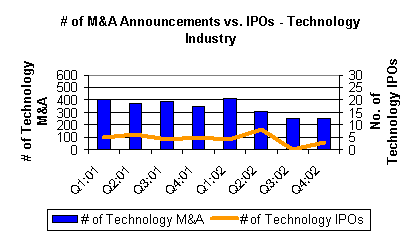|
|
| Home - Software M&A Review - Mar 03 Issue |
Software M&A: Outlook for 2003 |
By Bruce Milne, Chief Executive Officer, Corum Group
Despite recent significant declines from the peaks of 1999 and 2000, M&A activity is expected to increase 40% in 2003. M&A is still the best route to enhanced growth and liquidity for private software companies. Here are the reasons why and what factors will influence 2003 activity:
Software companies must grow to survive.
Particularly for software product companies, low variable costs for incremental sales and high up front costs for product and channel development, as well as branding, provide big benefits in terms of economies of scale. Volatile financial markets also place a premium on size, in part because the real assets such as employees, customer relationships and intellectual property, are intangible and very difficult to assess. In a market of often-rapid consolidation and evolution, a software firmís value may be diminished or even negated with just a few strategic acquisitions in the market. Within a matter of weeks, a company can find itself competing with a better-known brand/trade names. This dynamic is something smaller firms always worry about, especially in times of recession. Skeptical users will often look beyond a technology edge a smaller firm may posses to whether they believe the firm will survive, and will often buy from the larger competitor as a result. Clearly, there are significant costs involved in conversion, integration and user training of major systems. There is a resulting comfort and security factor for IT decision-makers selecting large suppliers with known brands, thereby shortening the sales cycle and increasing the close rate.
Entrepreneurs rarely scale.
Start-up companies require different executive skills than those required by companies that have surpassed the 20, 50 or 200 employee thresholds. It is very rare for entrepreneurs to achieve these thresholds without augmenting the executive team with leaders skilled in the more process-oriented operations of larger companies. As explained above, if the company doesnít grow in its marketplace, it may not survive. The technically-oriented founder of a current client is seeking to be acquired by a strategic buyer so that he may spend more time doing what he likes and is most proficient doing. At the same time, his company will benefit from the additional executive skills of the buyer to sustain continued growth.
Financing is an interim step.
For entrepreneurs, strategies to achieve faster growth can include VC funding, an IPO or M&A. VC funding is only an important step along the growth curve, because it usually doesnít help the founders or early investors realize value, nor does it quickly bring other potential M&A benefits such as distribution channels, brand, complementary products, new technologies, or domain expertise. Even an IPO may be bittersweet as insider trading restrictions may limit liquidity and many public companies do not retain analyst and investor attention, resulting in more than 25% of public software companies in North America having a market value of less than $6M.
Most successful software companies use M&A as part of their growth strategy.
Over the last two years the largest firms in the industry have made many acquisitions. This includes Microsoft, Oracle, Sun, IBM, Symantec and many others.
M&A is a vehicle to acquire key technology, domain knowledge, customer base, distribution channels, geographical presence, etc. much more quickly and with potentially lower risk than through internal growth. This is particularly true now that many companies have reduced staff developing new business initiatives. Historically, long-term survivors and industry leaders invest during recession periods to strengthen and consolidate their position. They know that innovation is the key to keeping pace in world markets where the competition never sleeps. So, now is the time to take a long-term perspective on partnering. M&A activity still dwarfs IPO activity, up to 50 times more likely, and is today the clear option for those seeking enhanced growth and liquidity.

Corum Group tracked more than 1,300 software and IT service company transactions in 2002. Many industry pundits would lead you to believe that the M&A markets were dead in 2002. This is simply not true. These analysts are not tracking deals under $50 million dollars. In fact, 71% of the deals announced this year were under $50 million. Further, as mentioned earlier, many of the buyers are not on the radar screen of most firms because of their size, or the fact that they are private. In fact, 44% of the buyers this past year were privately held, all of which Corum tracks in a proprietary database that includes more than 70,000 worldwide contacts.
|
|


|

